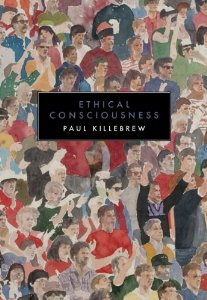This article first appeared as a post titled "Best Thing I’ve Read This Week: Ethical Consciousness" at Vouched Books on 31 July 2013
 In “On a Finger,” which appears near the beginning of Paul Killebrew’s second full-length collection of poems Ethical Consciousness (Canarium Books, 2013), the author writes:
In “On a Finger,” which appears near the beginning of Paul Killebrew’s second full-length collection of poems Ethical Consciousness (Canarium Books, 2013), the author writes:
To this extent, small “Certainties form” within a line, then “disband” as the poem progresses to the next line. But simultaneously with this formation and deformation, an overall rhythm and logic accrue as the poem proceeds, thus “cyclically realign[ing]” the poem with different words and patterns of thought. In other words, one could say that the poet composes the selections within this book as a “series of / statements,” which he “arranges” and re-arranges into a “dizzying / complexity” of “repeating / …sentences” and concepts.
Similarly in “Muted Flags,” the book’s final thirty-three paged poem, the speaker recounts a dream wherein:
One could argue, then, that the aesthetic of these poems and the ethical consciousness they promote rely on the interplay between micro-level and macro-level poetics, as well as a negotiation between the individual and community. In other words, Killebrew fosters a type of speech that acts as a “vessel / for transporting thought across dim borders” wherein he addresses “an exact person,” but also the “relationships among” persons as they form in “words / in a conversation” (52): a poetry that, both in content and form, seeks to reconcile the differences between part and whole, the singular and the many.
 In “On a Finger,” which appears near the beginning of Paul Killebrew’s second full-length collection of poems Ethical Consciousness (Canarium Books, 2013), the author writes:
In “On a Finger,” which appears near the beginning of Paul Killebrew’s second full-length collection of poems Ethical Consciousness (Canarium Books, 2013), the author writes:You moved closerAnd in the title poem, which immediately follows “On a Finger,” Killebrew writes:
and for the first time
I could see the pattern.
Certainties form,
disband, and
cyclically realign
under different colors,
but each prayer
from the angle of blunt attraction
had a sender,
and every afternoon
its silhouette. (18)
It’s as if the selfThese two passages provide a fairly accurate account of both the aesthetic tendencies and thematic concerns found within Ethical Consciousness. For starters, Killebrew primarily composes poems that contain lines only a few words in length, thus cutting syntactical (and conceptual) units into discrete elements; yet due to the enjambment that pervades the poems, he maintains a fluid movement and coherent rhetoric.
were a series of
statements
occasionally arranged
in dizzying
complexity but
mostly repeating
ten or eleven sentences
from the brief oeuvre
of a personality
that grows only
like a balloon—
never more surface,
just more tension
as the surface
spreads. (22)
To this extent, small “Certainties form” within a line, then “disband” as the poem progresses to the next line. But simultaneously with this formation and deformation, an overall rhythm and logic accrue as the poem proceeds, thus “cyclically realign[ing]” the poem with different words and patterns of thought. In other words, one could say that the poet composes the selections within this book as a “series of / statements,” which he “arranges” and re-arranges into a “dizzying / complexity” of “repeating / …sentences” and concepts.
Similarly in “Muted Flags,” the book’s final thirty-three paged poem, the speaker recounts a dream wherein:
I was surroundedAs the dream progresses, the speaker walks among the choir of voices, listening to each one of them in order to hear how:
by a choir
of hundreds, all
of them speaking
the question
in unison, with
exactly the same
inflections, inflections
that cycled through
a full range of
emotions—calm
sobriety, anger,
resignation, ecstasy,
and so on—
never hitting
any particular
emotional register
more than once
the entire night. (83)
his or her voiceJust as the lines in each of Killebrew’s poems are both distinct units and parts of a whole, so too are the voices of the “choir / of hundreds” both “enmeshed / …and distinct” while cycling through a variety of “emotional registers.”
was both enmeshed
with and distinct
from the whole,
and then I moved
back to the center
of the ring
they had formed,
their sound intensifying
into a physical
pressure on all
sides of my body (84)
One could argue, then, that the aesthetic of these poems and the ethical consciousness they promote rely on the interplay between micro-level and macro-level poetics, as well as a negotiation between the individual and community. In other words, Killebrew fosters a type of speech that acts as a “vessel / for transporting thought across dim borders” wherein he addresses “an exact person,” but also the “relationships among” persons as they form in “words / in a conversation” (52): a poetry that, both in content and form, seeks to reconcile the differences between part and whole, the singular and the many.

No comments:
Post a Comment